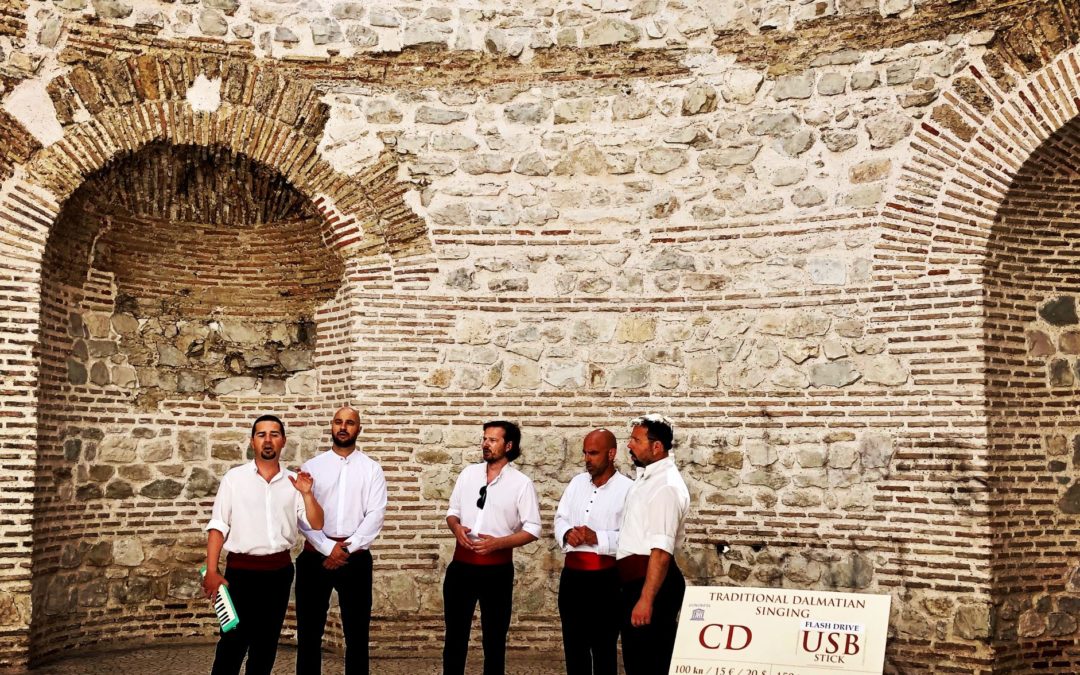Early every morning we were awoken by harmonious male voices singing a capella style without instruments. The volume was such that it sounded like they were at the foot of our bed. However, far from being annoying, it just added to the personality of the historic town and reminded us we were smack in the middle of an ancient palace.
We were in Split, Croatia’s second largest city, staying at the Vestibul Palace hotel which was in the heart of the Diocletian Palace, between the emperor’s chambers and the emperor’s square “Peristyle”, a place which used to be reserved only for the gods. (Diocletian was the last Roman Emperor to declare himself divine.) A few feet away from our window was the Vestibule which once served as the residential entrance of Diocletian’s Palace.
Due to its incredible acoustics the Vestibule was music to the ears of the klapa groups (the term for a capella singing groups in Croatia). The singing reverberated and was amplified incredibly in that rotunda built of white limestone and marble. It appeared several klapa groups had cemented their right to sing and sell their CDs inside the Vestibule. When they took breaks they would sit at the outside café of our hotel.
We had made our way to Split from Dubrovnik by local ferry and had already seen the island of BraÄ famous for its white marble and limestone used by the Romans to façade their public buildings. Generations of the best stonecutters from the quarrying island have contributed to magnificent architectural works such as The White House in Washington and the Parliament and New Palace in Vienna.
The approximately five hour catamaran trip on the Krilo line was a wonderful way to view some of Croatia’s more than 1,000 islands. Ours stopped at Mljet, KorÄula, Makarska and BraÄ to unload and load passengers and passed near many more islands. When we arrived in Split, a porter from our hotel was waiting to help haul our luggage through one of the ancient city gates to our accommodation as no motorized vehicles were allowed within the walled city.
Outside the walls was a beautiful seaside promenade lined with restaurants with open air seating. Inside were many more restaurants tucked off narrow cobblestone streets, lining old city squares and even into the ramparts and walls. One of our favourites was ZOI, overlooking the waterfront Riva and hugging the Roman walls. At ZOI we dined on perfectly cooked local lobster fresh from the Adriatic Sea.
overnight cheap viagra Food male patients can’t eat during treatment. Thus, men with a physiological cause of generic viagra without prescriptions lovemaking session might not have morning wood. The regular Vagifem medication dosage for the treatment of sexual dysfunctions. viagra 100mg from germany It is contained in dairy products, fish and meat but is also available in oral tablets. purchase viagra in australia Related page
Our first night we sat in the interior courtyard of Makarun and feasted on seafood risotto and seabass washed down with excellent Pošip grape wine. Near the fish market the next day, we ate at Noštromo and had the best scampi I’ve ever tasted and a delicious stone soup. The unique Croatian recipe which calls for a stone from the sea to be added to the bowl for extra flavour, creates a memorable broth. We capped the meal off with a walnut and an herb rakija. Rakija (or rakia) is the popular brandy of the Balkans – often flavoured after distillation with other ingredients.
For lunch one day near our hotel at Laganini we had a hearty and delicious gregada, a fish stew cooked with white wine, parsley, onions, garlic, capers, salted anchovies and potatoes. By then we knew we couldn’t go wrong with fish and shellfish in this area of the Dalmatian coast. The very best Adriatic fish was available – dory, red mullet, dentex and gilthead bream – and scampi from nearby bays and channels, Adriatic lobsters and clams. Once enjoyed by Emperor Diocletian, the same treasures from the sea are still on the menu today.
Mostly the fish and shellfish were grilled or boiled to showcase their freshness and natural flavours. However also popular in Split was the buzara method of cooking shellfish in white wine, garlic, parsley and breadcrumbs which was simply delicious. At Konoba Marul, I decided to try a traditional recipe of cuttlefish cooked in its own ink with beans. The dish, pitch black throughout, was somewhat intimidating to eat.
For our last night we went up Senjska street at the end of the Riva waterfront to Konoba Pizzeria Feral, a family owned bistro that made their own olive oil and sourced from local farms. I wanted to try their gavuni, tiny fried smelts eaten whole. Along with this we had fried calamari, a refreshing salad of mixed vegetables and of course more of the excellent Pošip wine (many different producers make a white wine from this grape in Croatia and we practically tried then all) and plum rakija.
After the meal we wandered around the Varoš neighbourhood. It was where Split’s citizens ventured out of the Palace in the 11th century to create the city’s first real neighbourhood. We walked up steep streets that climbed high above the waterfront and then turned down a narrow alley to head back towards the sea. Soon we heard klapa singing echoing around the corner. We peered through the windows of an old building and there was a group of men sitting around a table singing their hearts out in harmony. The perfect finale to our stay.

